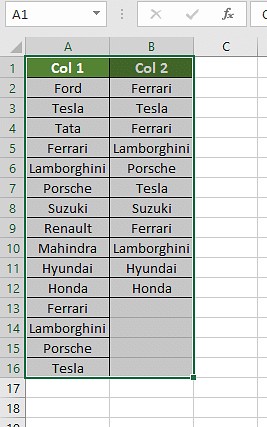Comparing column values in Excel is a crucial task for data analysis and reporting. Doing this manually can be time-consuming and error-prone, especially with large datasets. Fortunately, Excel offers several efficient methods to compare columns and identify matches, differences, and unique values. This guide provides a comprehensive overview of these techniques.
Methods for Comparing Excel Columns
Excel provides a variety of tools and functions to compare column data:
1. Conditional Formatting
Conditional formatting allows you to visually highlight cells based on their values. To compare columns:
- Select the columns you want to compare.
- Go to Home > Conditional Formatting > Highlight Cells Rules.
- Choose Duplicate Values to highlight matching values or Unique Values to highlight differing values.
2. Equals Operator (=)
The equals operator directly compares two cells. Create a new column and use a formula like =A1=B1. This returns TRUE if the values match and FALSE if they don’t. You can enhance this with the IF function to display custom messages: =IF(A1=B1,"Match","No Match").
3. VLOOKUP Function
VLOOKUP searches for a value in the first column of a table and returns a value in the same row from a specified column. To compare columns:
- Create a new column for results.
- Use the formula
=VLOOKUP(A1,$B$1:$B$10,1,FALSE). This searches for the value of A1 in column B. A#N/Aerror indicates no match. - Use
IFERRORto handle errors:=IFERROR(VLOOKUP(A1,$B$1:$B$10,1,FALSE),"No Match").
4. IF Formula with EXACT Function
For case-sensitive comparisons, combine the IF and EXACT functions: =IF(EXACT(A1,B1),"Match","No Match"). EXACT returns TRUE only if the values are identical, including case.
Choosing the Right Method
- Conditional Formatting: Best for quickly visualizing matches and differences.
- Equals Operator: Simple and direct for basic comparisons.
- VLOOKUP: Useful for finding matches in a larger table and returning corresponding data.
- IF with EXACT: Essential for case-sensitive comparisons.
Comparing Multiple Columns and Advanced Scenarios
For more complex comparisons:
- Multiple Columns: Use
ANDfor matching across multiple columns:=IF(AND(A1=B1,A1=C1),"Match","No Match"). - Partial Matches: Use wildcards () with
VLOOKUPfor partial matches: `=VLOOKUP(A1&”“,$B$1:$B$10,1,FALSE)`. - Highlighting Row Differences: Use conditional formatting with a formula like:
=AND($A1=$B1,$A1=$C1). - Finding Unique Values: Use
COUNTIFto identify values not present in another column:=IF(COUNTIF($B:$B,$A1)=0,"Unique","").
Conclusion
Excel provides a powerful toolkit for comparing column values, from simple comparisons to complex data analysis. By understanding these methods and choosing the appropriate technique for your specific needs, you can efficiently analyze your data and extract valuable insights. Mastering these skills is essential for anyone working with data in Excel.

